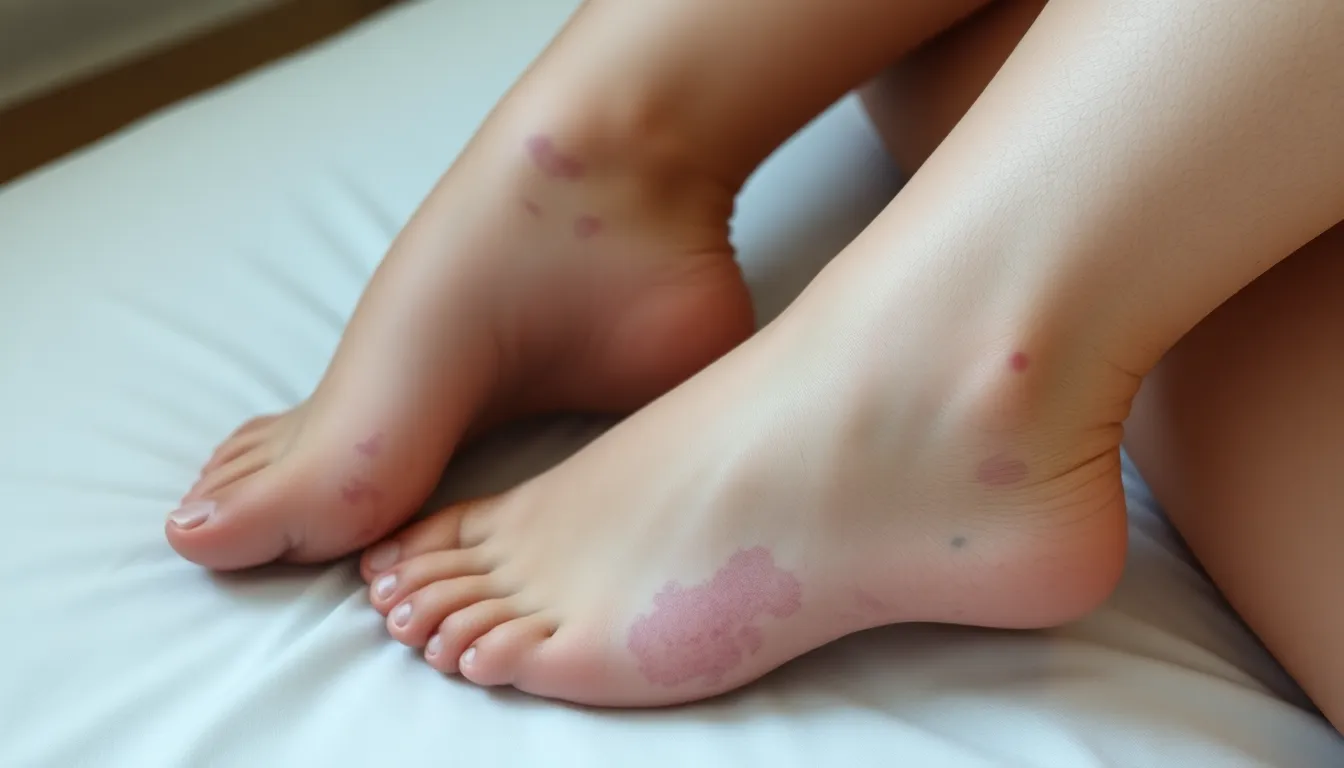Ever looked down and thought your legs just auditioned for a role in a horror movie? Purple and blotchy skin can be alarming, but don’t panic just yet. It’s not a sign that you’re turning into a walking grape. Instead, it could be your body’s way of sending a message that deserves attention.
From circulation issues to pesky skin conditions, the reasons behind those colorful patches can range from the mildly amusing to the downright concerning. Understanding what’s going on can help you put the “fun” back in functional legs. So let’s dive into the mystery behind those purple splotches and discover whether you need a doctor or just a good pair of compression socks.
Table of Contents
ToggleUnderstanding Leg Discoloration
Leg discoloration often stems from several underlying factors. Circulation issues frequently cause purple blotches, indicating reduced blood flow. Venous insufficiency refers to the valve failure in veins, leading to blood pooling and discoloration. Conditions like eczema or dermatitis may also provoke skin changes, prompting irritation and color shifts.
Some individuals might notice leg discoloration due to prolonged sitting or standing. Blood can accumulate in the lower extremities, resulting in a purple hue. Compression socks serve as a practical solution, aiding circulation and minimizing discoloration.
Bruising can yield purple spots, occurring from minor injuries or even unnoticed impacts. In addition, age-related changes can affect skin and veins, making discoloration more noticeable among older adults.
Certain medical conditions, such as diabetes or peripheral artery disease, require careful consideration due to potential complications. Seeking professional evaluation is crucial when discoloration accompanies pain, swelling, or warmth.
Genetic factors might result in conditions like livedo reticularis, creating a lace-like pattern on the skin. Lifestyle choices also play a role; smoking or obesity complicates circulation, contributing to leg discoloration.
Maintaining a healthy weight and regular exercise can enhance circulation, potentially reducing issues. Individuals should monitor changes and consult a healthcare provider for persistent or concerning symptoms.
Common Causes of Purple and Blotchy Legs

Purple, blotchy legs often signal underlying issues. Various conditions contribute to this skin discoloration.
Poor Circulation
Poor circulation frequently results in noticeable purple blotches on the legs. Reduced blood flow to the extremities, caused by venous insufficiency or prolonged inactivity, aggravates this condition. Lack of movement allows blood to pool, creating discoloration. Compression socks often help improve circulation, alleviating symptoms. Regular walking or leg exercises can enhance blood flow, reducing the likelihood of these purple patches. Monitoring symptoms is essential, especially if discoloration occurs alongside pain or swelling.
Skin Conditions
Skin conditions like eczema and dermatitis contribute to purple and blotchy appearances. Inflammation from these conditions can lead to changes in skin color, often manifesting as redness or purple hues. Treatment for these skin disorders may include topical steroids or moisturizers. It’s important to address any rashes or irritation early to prevent worsening symptoms. Consulting a dermatologist can provide tailored solutions based on individual skin needs. Identifying triggers for skin conditions, such as allergens or irritants, can also help manage symptoms effectively.
Blood Clots
Blood clots present significant health risks and often cause discoloration in the legs. When a clot obstructs blood flow, the affected area may turn purple or blotchy, indicating serious issues. Signs of blood clots include sudden swelling, pain, or warmth in the leg. Immediate medical attention is crucial if these symptoms occur. Diagnosis typically involves imaging tests, like ultrasounds. Treatment options range from anticoagulant medications to, in severe cases, surgical interventions. Knowing the risk factors for blood clots, such as prolonged immobility, aids in prevention and early detection.
When to Seek Medical Attention
Noticing leg discoloration may necessitate medical evaluation, especially when accompanied by troubling symptoms. Recognizing warning signs can help determine when to consult a healthcare provider.
Warning Signs
Signs indicating a potential need for medical attention include pain, swelling, or a notable increase in warmth around the affected area. Experiencing sudden changes in color, especially if the legs appear significantly more purple, heightens concern. Individuals with pre-existing conditions like diabetes or heart disease should monitor symptoms closely. Unexplained bruising without injury can signal underlying issues, while persistent discoloration, despite lifestyle adjustments, warrants professional evaluation.
Recommended Tests
A healthcare provider may recommend specific tests to diagnose the underlying cause of leg discoloration. Blood tests can assess circulation issues or check for clotting disorders. Doppler ultrasound may evaluate blood flow in the veins, helping identify any blockages. Skin biopsies might be necessary to confirm skin condition diagnoses like dermatitis. Those experiencing significant symptoms should pursue a thorough evaluation for early intervention.
Treatment Options
Addressing purple and blotchy legs involves various strategies. Treatment options may include lifestyle changes and medical interventions.
Lifestyle Changes
Incorporating regular exercise enhances circulation and reduces discoloration risk. Maintaining a healthy weight can alleviate pressure on veins. Compression stockings promote better blood flow in the legs. Staying hydrated supports skin health and improves circulation overall. Elevating legs during rest periods encourages blood return to the heart. Avoiding long periods of sitting or standing minimizes blood pooling. Modifying diet to include anti-inflammatory foods may help reduce underlying causes.
Medical Interventions
Consulting a healthcare provider is vital for persistent or severe symptoms. Varicose vein treatments may include sclerotherapy or laser therapy to enhance circulation. Prescribing medications can address underlying issues like blood clots or skin conditions. Diagnostic imaging, such as Doppler ultrasound, helps evaluate blood flow problems. Treatment for skin conditions may involve corticosteroids or other topical agents. In some cases, more invasive procedures, like vein stripping, may be necessary. Regular follow-ups ensure ongoing assessment and management of the condition.
Purple and blotchy legs can signal various underlying issues that deserve attention. While many causes are benign and manageable with lifestyle changes like exercise and proper hydration, some may require medical evaluation. Recognizing when to seek help is crucial. If discoloration is accompanied by pain swelling or warmth it’s essential to consult a healthcare provider promptly. Understanding the potential causes and taking proactive steps can help maintain healthy circulation and skin appearance. Monitoring changes in leg color and seeking guidance when necessary can lead to effective management and peace of mind.


